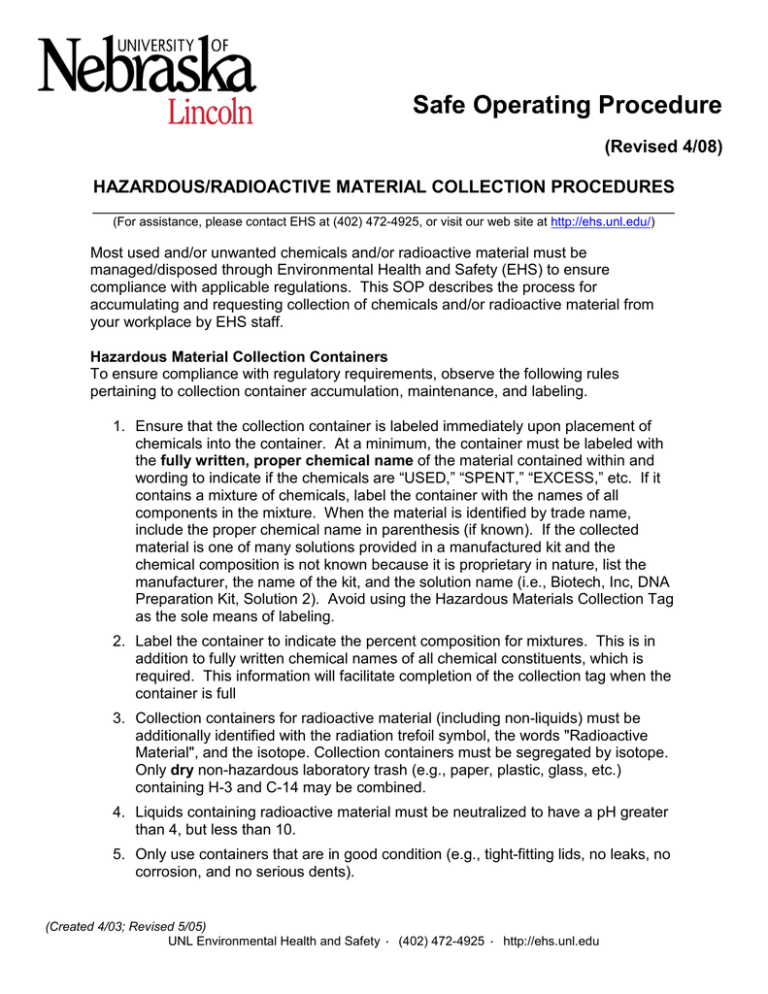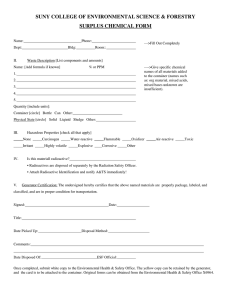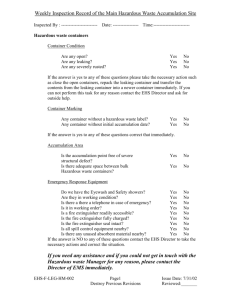Safe Operating Procedure (Revised 4/08) HAZARDOUS/RADIOACTIVE MATERIAL COLLECTION PROCEDURES
advertisement

Safe Operating Procedure (Revised 4/08) HAZARDOUS/RADIOACTIVE MATERIAL COLLECTION PROCEDURES _____________________________________________________________________ (For assistance, please contact EHS at (402) 472-4925, or visit our web site at http://ehs.unl.edu/) Most used and/or unwanted chemicals and/or radioactive material must be managed/disposed through Environmental Health and Safety (EHS) to ensure compliance with applicable regulations. This SOP describes the process for accumulating and requesting collection of chemicals and/or radioactive material from your workplace by EHS staff. Hazardous Material Collection Containers To ensure compliance with regulatory requirements, observe the following rules pertaining to collection container accumulation, maintenance, and labeling. 1. Ensure that the collection container is labeled immediately upon placement of chemicals into the container. At a minimum, the container must be labeled with the fully written, proper chemical name of the material contained within and wording to indicate if the chemicals are “USED,” “SPENT,” “EXCESS,” etc. If it contains a mixture of chemicals, label the container with the names of all components in the mixture. When the material is identified by trade name, include the proper chemical name in parenthesis (if known). If the collected material is one of many solutions provided in a manufactured kit and the chemical composition is not known because it is proprietary in nature, list the manufacturer, the name of the kit, and the solution name (i.e., Biotech, Inc, DNA Preparation Kit, Solution 2). Avoid using the Hazardous Materials Collection Tag as the sole means of labeling. 2. Label the container to indicate the percent composition for mixtures. This is in addition to fully written chemical names of all chemical constituents, which is required. This information will facilitate completion of the collection tag when the container is full 3. Collection containers for radioactive material (including non-liquids) must be additionally identified with the radiation trefoil symbol, the words "Radioactive Material", and the isotope. Collection containers must be segregated by isotope. Only dry non-hazardous laboratory trash (e.g., paper, plastic, glass, etc.) containing H-3 and C-14 may be combined. 4. Liquids containing radioactive material must be neutralized to have a pH greater than 4, but less than 10. 5. Only use containers that are in good condition (e.g., tight-fitting lids, no leaks, no corrosion, and no serious dents). (Created 4/03; Revised 5/05) UNL Environmental Health and Safety · (402) 472-4925 · http://ehs.unl.edu 6. Choose containers that are compatible with the contents (e.g., do not place acids in metal containers). 7. Do not place incompatible or unlike chemicals in the same container, or use a container that previously held an incompatible chemical. Do not combine used radioactive material with used non-radioactive material. 8. Do not overfill the container. Leave 3-inches of headspace in 1-gallon containers and 1-inch of headspace in 5-gallon containers. 9. Collection containers must be kept closed at all times, except when immediately adding or removing materials. Do not leave funnels in collection containers. Use a lid that will prevent the material from spilling if the container is tipped over. 10. Store the container in a suitable location for the hazards present (i.e., in a flammable liquids storage cabinet if the contents are flammable, etc.) and utilize secondary containment to minimize adverse effects of leaks and spills. 11. Store the container only in the same room where it was generated. Never move a container from one location to another while awaiting pickup. Never pour the content into a central collection container (i.e.; drum) located elsewhere. 12. Once the container is full, is at the end of a process, or it is decided that a container of unused or reusable material is no longer needed, request collection by completing a hazardous material collection tag following the process described below. Hazardous Material Collection Tags A tag system is used to identify those chemicals intended for collection by EHS. The tag is also used as a notification system to alert EHS staff that chemical collection is requested at a given location. Tags are referred to as “Hazardous Materials Collection Tags” and they are used for a variety of materials, including used chemicals, unwanted excess chemicals, regulated empty chemical containers, and radioactive materials. Usually, a single tag is used for each container. However, small containers (e.g., vials) of the same material that are packaged in a common outer container can be tagged with a single tag. Contact EHS at 472-4925 to request a supply of blank tags. Note: if you are planning a laboratory cleanout or have a large quantity of chemicals to turn in, please refer to EHS SOP, Laboratory Decommissioning and contact us before requesting blank tags. A completed tag should be affixed to a container when the container is full, it is decided that a container of unused or reusable material is no longer needed, or no more material is intended to be added to the container (i.e., at the end of a process). Tags consist of three sheets of carbon-less paper. Use a pen and press hard when writing to make sure the information is legibly transferred to the bottom copy. Please follow these instructions for completing tags: EHS Use Only: Do not write in this section of the tag. (Created 4/03; Revised 5/05) UNL Environmental Health and Safety · (402) 472-4925 · http://ehs.unl.edu Authorized User/Principal Investigator: Enter the first and last name of the researcher/supervisor of the work area. Do not use names of students, temporary employees, or technicians. Phone #: Enter a phone number for the person who has knowledge of the material. Completed by: Enter the name of the person who completed the tag. Department: Enter the name of the department (e.g., Chemistry). Campus: Enter either East Campus (EC) or City Campus (CC). Building/Room #: Enter the actual location where the material is located. Do not use office or mailing addresses. Container Size: Enter the actual size of the container (e.g., vial, pint, gallon, quart, 5 gallon,13-gallon bag, 30 gallon, 55 gallon, etc.). Physical State: Check the box that most correctly describes the material (i.e., liquid, solid, or gas). Container Type: Check the appropriate box to indicate if the container is fiber (e.g., bag), metal, glass, or plastic. Used/Unused/Unopened: Check the appropriate box to indicate whether the chemical has been used in a process or is unused. If the chemical is unopened, enter the expiration date. Chemical Composition/Item Description: Enter the full chemical name of all chemical constituents reasonably expected to be present in the material. ALL CHEMICAL CONSTITUENTS MUST BE LISTED REGARDLESS OF CONCENTRATION--THERE ARE NO DE MINIMIS QUANTITIES. LIST CHEMICALS WITH FULL NAMES – DO NOT USE ABBREVIATIONS. List the approximate concentration of each chemical constituent (see examples below). • If the material is a commercial product, include both the product name (e.g., Lime Green Paint manufactured by ABC Paint Company) and chemical constituents listed on the label (e.g., contains 98% petroleum distillates, 1.999 % sodium silicate, and 0.001% mercury) • If the material is a mixture, indicate the approximate percentage (or amount) of each component (e.g., 1 mL chloroform extract in 99 mLs of Scintiverse). If the collected material is one of many solutions provided in a manufactured kit, the chemical composition may not be known because it is proprietary. In this case, list the manufacturer, the name of the kit, and the solution name (e.g., Biotech, Inc, DNA Preparation kit, Solution 2). If the waste is a lab made solution, indicate the percentage of all constituents (20% Ethanol, 80% Acetone). (Created 4/03; Revised 5/05) UNL Environmental Health and Safety · (402) 472-4925 · http://ehs.unl.edu If the material does not contain a radioactive isotope, tear off the "Radioactive Material Only" section of the tag at the perforation and discard; then mail the top copy of the tag to EHS at 3630 EC Loop, EC-0824, and attach the remaining copies to the collection container. Contact EHS if your materials have not been collected within seven (7) working days of mailing the tag. (Created 4/03; Revised 5/05) UNL Environmental Health and Safety · (402) 472-4925 · http://ehs.unl.edu Examples of completed Collection Tags for materials without radioactive isotopes Chemicals Commercial Products (Created 4/03; Revised 5/05) UNL Environmental Health and Safety · (402) 472-4925 · http://ehs.unl.edu Additional Instructions for Completing Tags for Radioactive Material AU #: Enter the Authorized User number assigned by the EHS Radiation Safety Program. Nuclide: Enter the radionuclide in the material (i.e., H-3, C-14, S-35, or P-32). Only one nuclide should be present in each container. Only dry laboratory trash (e.g., paper, plastic, glass, etc.) containing H-3 and C-14 may be combined into a single container. Activity: Enter the total activity (mCi) of the material in the container (one mCi = 1000 µCi = 2.2x109 dpm). Total Liquid Volume: If the material is liquid, enter the total volume. For liquid scintillation vials, enter the total volume of liquid in all of the vials. Include the words “LSC Vials” under the Chemical Composition/Item Description. Also, include the trade name the LSC cocktail (see example below). Number of Scintillation Vials: If the material consists of scintillation vials, enter the total number of vials in the package. Otherwise leave this field blank. Volume of Scintillation Vials: If the material consists of scintillation vials, enter the volume of liquid in each vial. Mail the top copy of the tag to EHS at 3630 EC Loop, EC-0824, and attach the remaining copies to the collection container. Contact EHS if your materials have not been collected within seven (7) working days of mailing the tag. Examples of completed Collection Tags for materials with radioactive isotopes are referenced below. (Created 5/01, Revised 5/05; 2/06) UNL Environmental Health and Safety · (402) 472-4925 · http://ehs.unl.edu Radioactive Solids Radioactive Liquids (Created 5/01, Revised 5/05; 2/06) UNL Environmental Health and Safety · (402) 472-4925 · http://ehs.unl.edu





